Sustainable Cities: ENGT5115 Sustainable Development Essay
VerifiedAdded on 2022/08/26
|10
|3488
|30
Essay
AI Summary
This essay delves into the concept of sustainable cities within the context of sustainable development (SD), emphasizing the importance of urban planning and design in ensuring a sustainable future. The essay explores how sustainable cities are designed to minimize environmental impact, promote social equity, and provide a high quality of life for current and future residents. It highlights key features such as accessible resources, efficient public transport, and the use of renewable energy. The essay discusses the relevance of the 17 Sustainable Development Goals (SDGs), particularly SDG-11, in achieving sustainable urban environments. It also examines the challenges faced by cities, including inequality, pollution, and vulnerability to climate change, while emphasizing the role of community involvement and sustainable practices in overcoming these challenges. The essay concludes by advocating for the adoption of sustainable technologies, urban planning, and energy practices to promote a balanced approach to economics, ecology, culture, and politics, ensuring a sustainable future for all.
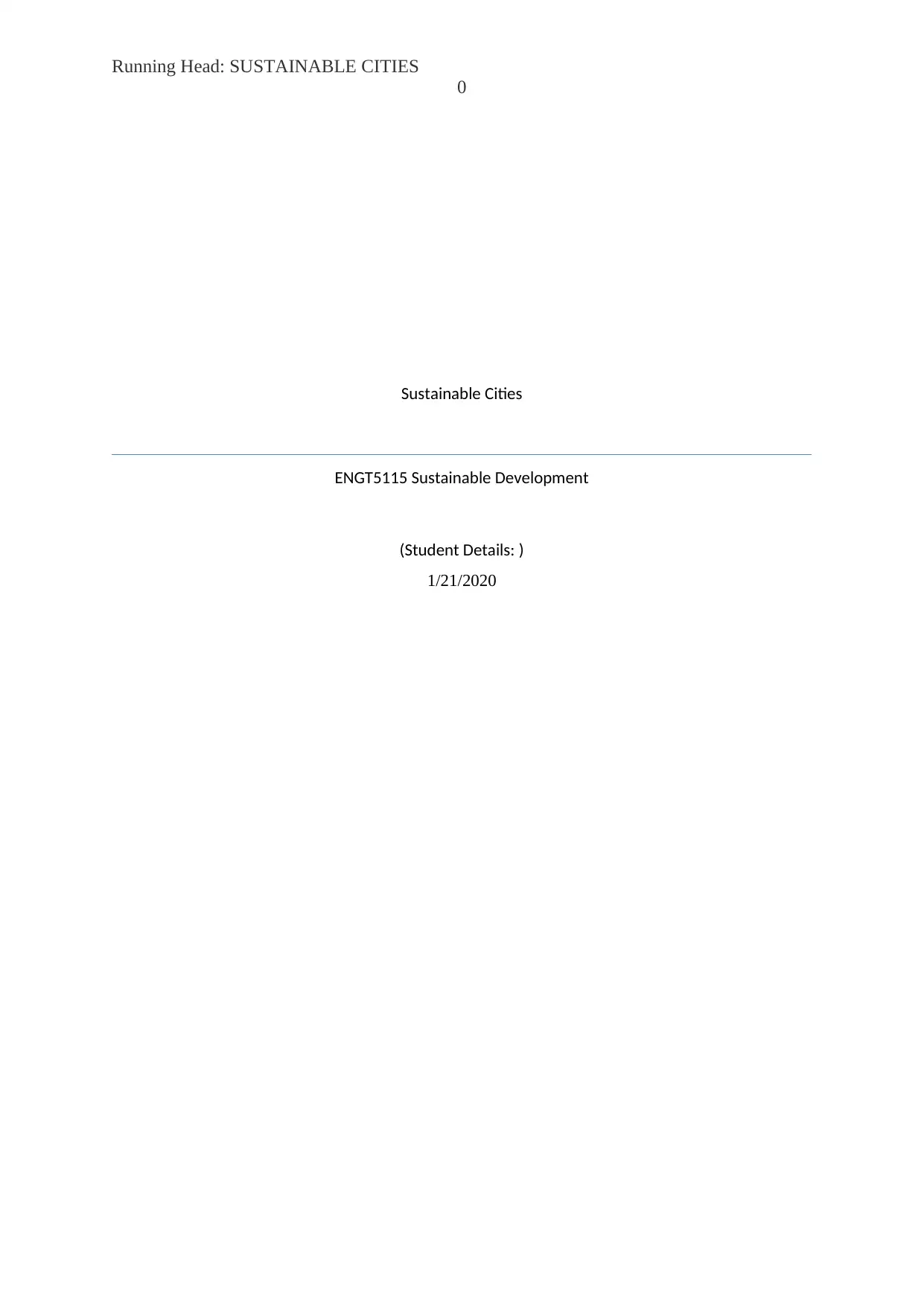
Running Head: SUSTAINABLE CITIES
0
Sustainable Cities
ENGT5115 Sustainable Development
(Student Details: )
1/21/2020
0
Sustainable Cities
ENGT5115 Sustainable Development
(Student Details: )
1/21/2020
Paraphrase This Document
Need a fresh take? Get an instant paraphrase of this document with our AI Paraphraser
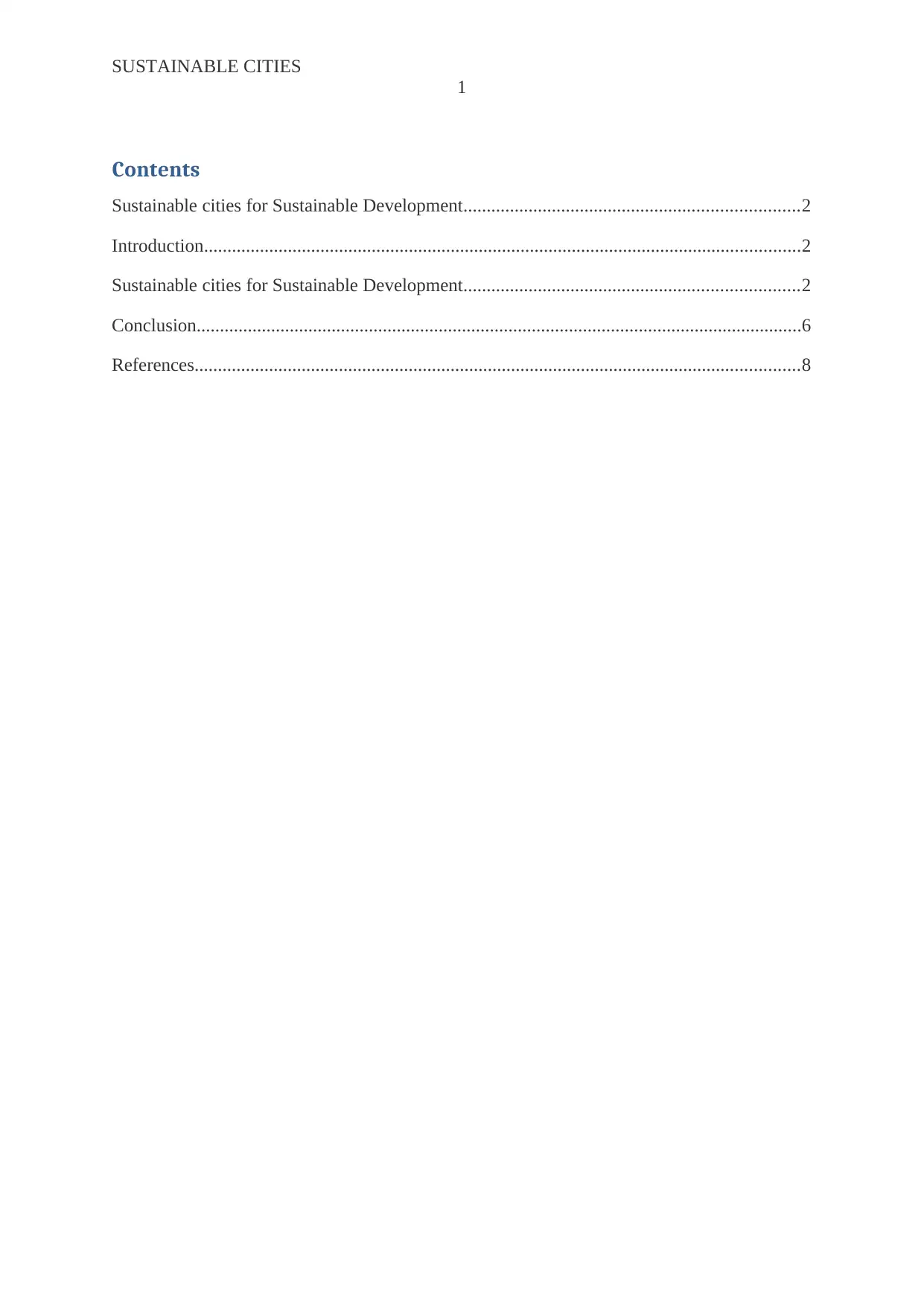
SUSTAINABLE CITIES
1
Contents
Sustainable cities for Sustainable Development........................................................................2
Introduction................................................................................................................................2
Sustainable cities for Sustainable Development........................................................................2
Conclusion..................................................................................................................................6
References..................................................................................................................................8
1
Contents
Sustainable cities for Sustainable Development........................................................................2
Introduction................................................................................................................................2
Sustainable cities for Sustainable Development........................................................................2
Conclusion..................................................................................................................................6
References..................................................................................................................................8
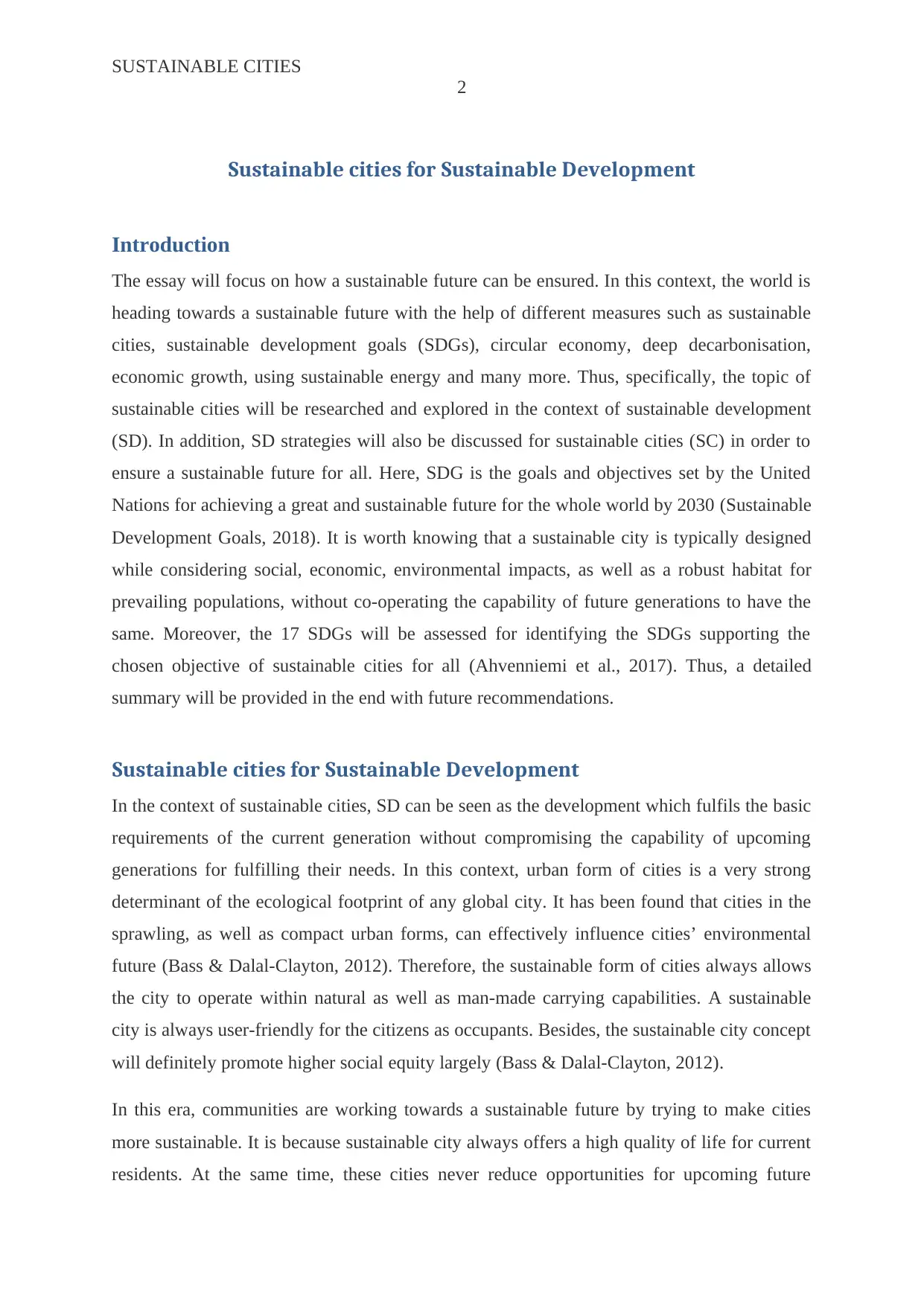
SUSTAINABLE CITIES
2
Sustainable cities for Sustainable Development
Introduction
The essay will focus on how a sustainable future can be ensured. In this context, the world is
heading towards a sustainable future with the help of different measures such as sustainable
cities, sustainable development goals (SDGs), circular economy, deep decarbonisation,
economic growth, using sustainable energy and many more. Thus, specifically, the topic of
sustainable cities will be researched and explored in the context of sustainable development
(SD). In addition, SD strategies will also be discussed for sustainable cities (SC) in order to
ensure a sustainable future for all. Here, SDG is the goals and objectives set by the United
Nations for achieving a great and sustainable future for the whole world by 2030 (Sustainable
Development Goals, 2018). It is worth knowing that a sustainable city is typically designed
while considering social, economic, environmental impacts, as well as a robust habitat for
prevailing populations, without co-operating the capability of future generations to have the
same. Moreover, the 17 SDGs will be assessed for identifying the SDGs supporting the
chosen objective of sustainable cities for all (Ahvenniemi et al., 2017). Thus, a detailed
summary will be provided in the end with future recommendations.
Sustainable cities for Sustainable Development
In the context of sustainable cities, SD can be seen as the development which fulfils the basic
requirements of the current generation without compromising the capability of upcoming
generations for fulfilling their needs. In this context, urban form of cities is a very strong
determinant of the ecological footprint of any global city. It has been found that cities in the
sprawling, as well as compact urban forms, can effectively influence cities’ environmental
future (Bass & Dalal-Clayton, 2012). Therefore, the sustainable form of cities always allows
the city to operate within natural as well as man-made carrying capabilities. A sustainable
city is always user-friendly for the citizens as occupants. Besides, the sustainable city concept
will definitely promote higher social equity largely (Bass & Dalal-Clayton, 2012).
In this era, communities are working towards a sustainable future by trying to make cities
more sustainable. It is because sustainable city always offers a high quality of life for current
residents. At the same time, these cities never reduce opportunities for upcoming future
2
Sustainable cities for Sustainable Development
Introduction
The essay will focus on how a sustainable future can be ensured. In this context, the world is
heading towards a sustainable future with the help of different measures such as sustainable
cities, sustainable development goals (SDGs), circular economy, deep decarbonisation,
economic growth, using sustainable energy and many more. Thus, specifically, the topic of
sustainable cities will be researched and explored in the context of sustainable development
(SD). In addition, SD strategies will also be discussed for sustainable cities (SC) in order to
ensure a sustainable future for all. Here, SDG is the goals and objectives set by the United
Nations for achieving a great and sustainable future for the whole world by 2030 (Sustainable
Development Goals, 2018). It is worth knowing that a sustainable city is typically designed
while considering social, economic, environmental impacts, as well as a robust habitat for
prevailing populations, without co-operating the capability of future generations to have the
same. Moreover, the 17 SDGs will be assessed for identifying the SDGs supporting the
chosen objective of sustainable cities for all (Ahvenniemi et al., 2017). Thus, a detailed
summary will be provided in the end with future recommendations.
Sustainable cities for Sustainable Development
In the context of sustainable cities, SD can be seen as the development which fulfils the basic
requirements of the current generation without compromising the capability of upcoming
generations for fulfilling their needs. In this context, urban form of cities is a very strong
determinant of the ecological footprint of any global city. It has been found that cities in the
sprawling, as well as compact urban forms, can effectively influence cities’ environmental
future (Bass & Dalal-Clayton, 2012). Therefore, the sustainable form of cities always allows
the city to operate within natural as well as man-made carrying capabilities. A sustainable
city is always user-friendly for the citizens as occupants. Besides, the sustainable city concept
will definitely promote higher social equity largely (Bass & Dalal-Clayton, 2012).
In this era, communities are working towards a sustainable future by trying to make cities
more sustainable. It is because sustainable city always offers a high quality of life for current
residents. At the same time, these cities never reduce opportunities for upcoming future
⊘ This is a preview!⊘
Do you want full access?
Subscribe today to unlock all pages.

Trusted by 1+ million students worldwide
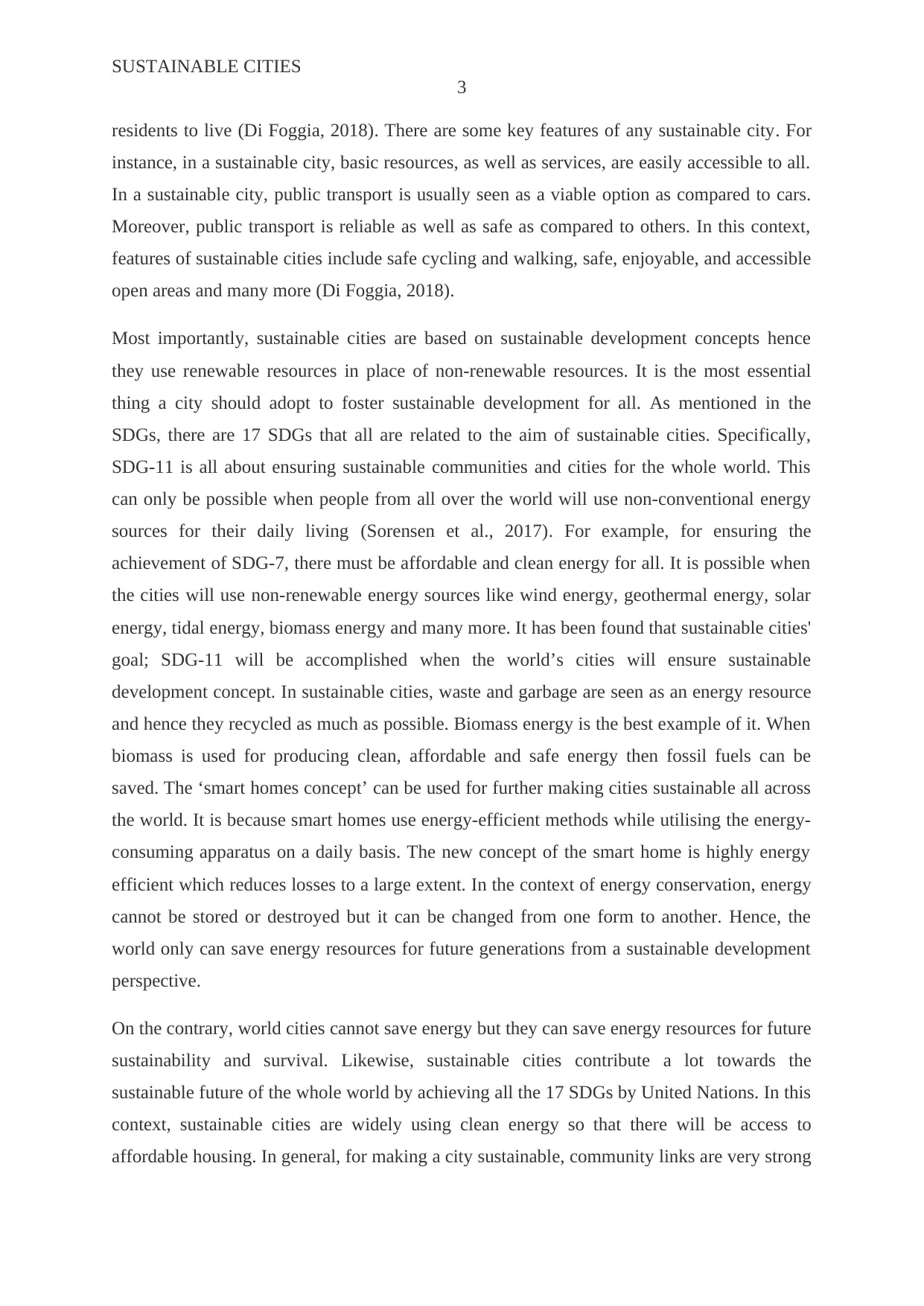
SUSTAINABLE CITIES
3
residents to live (Di Foggia, 2018). There are some key features of any sustainable city. For
instance, in a sustainable city, basic resources, as well as services, are easily accessible to all.
In a sustainable city, public transport is usually seen as a viable option as compared to cars.
Moreover, public transport is reliable as well as safe as compared to others. In this context,
features of sustainable cities include safe cycling and walking, safe, enjoyable, and accessible
open areas and many more (Di Foggia, 2018).
Most importantly, sustainable cities are based on sustainable development concepts hence
they use renewable resources in place of non-renewable resources. It is the most essential
thing a city should adopt to foster sustainable development for all. As mentioned in the
SDGs, there are 17 SDGs that all are related to the aim of sustainable cities. Specifically,
SDG-11 is all about ensuring sustainable communities and cities for the whole world. This
can only be possible when people from all over the world will use non-conventional energy
sources for their daily living (Sorensen et al., 2017). For example, for ensuring the
achievement of SDG-7, there must be affordable and clean energy for all. It is possible when
the cities will use non-renewable energy sources like wind energy, geothermal energy, solar
energy, tidal energy, biomass energy and many more. It has been found that sustainable cities'
goal; SDG-11 will be accomplished when the world’s cities will ensure sustainable
development concept. In sustainable cities, waste and garbage are seen as an energy resource
and hence they recycled as much as possible. Biomass energy is the best example of it. When
biomass is used for producing clean, affordable and safe energy then fossil fuels can be
saved. The ‘smart homes concept’ can be used for further making cities sustainable all across
the world. It is because smart homes use energy-efficient methods while utilising the energy-
consuming apparatus on a daily basis. The new concept of the smart home is highly energy
efficient which reduces losses to a large extent. In the context of energy conservation, energy
cannot be stored or destroyed but it can be changed from one form to another. Hence, the
world only can save energy resources for future generations from a sustainable development
perspective.
On the contrary, world cities cannot save energy but they can save energy resources for future
sustainability and survival. Likewise, sustainable cities contribute a lot towards the
sustainable future of the whole world by achieving all the 17 SDGs by United Nations. In this
context, sustainable cities are widely using clean energy so that there will be access to
affordable housing. In general, for making a city sustainable, community links are very strong
3
residents to live (Di Foggia, 2018). There are some key features of any sustainable city. For
instance, in a sustainable city, basic resources, as well as services, are easily accessible to all.
In a sustainable city, public transport is usually seen as a viable option as compared to cars.
Moreover, public transport is reliable as well as safe as compared to others. In this context,
features of sustainable cities include safe cycling and walking, safe, enjoyable, and accessible
open areas and many more (Di Foggia, 2018).
Most importantly, sustainable cities are based on sustainable development concepts hence
they use renewable resources in place of non-renewable resources. It is the most essential
thing a city should adopt to foster sustainable development for all. As mentioned in the
SDGs, there are 17 SDGs that all are related to the aim of sustainable cities. Specifically,
SDG-11 is all about ensuring sustainable communities and cities for the whole world. This
can only be possible when people from all over the world will use non-conventional energy
sources for their daily living (Sorensen et al., 2017). For example, for ensuring the
achievement of SDG-7, there must be affordable and clean energy for all. It is possible when
the cities will use non-renewable energy sources like wind energy, geothermal energy, solar
energy, tidal energy, biomass energy and many more. It has been found that sustainable cities'
goal; SDG-11 will be accomplished when the world’s cities will ensure sustainable
development concept. In sustainable cities, waste and garbage are seen as an energy resource
and hence they recycled as much as possible. Biomass energy is the best example of it. When
biomass is used for producing clean, affordable and safe energy then fossil fuels can be
saved. The ‘smart homes concept’ can be used for further making cities sustainable all across
the world. It is because smart homes use energy-efficient methods while utilising the energy-
consuming apparatus on a daily basis. The new concept of the smart home is highly energy
efficient which reduces losses to a large extent. In the context of energy conservation, energy
cannot be stored or destroyed but it can be changed from one form to another. Hence, the
world only can save energy resources for future generations from a sustainable development
perspective.
On the contrary, world cities cannot save energy but they can save energy resources for future
sustainability and survival. Likewise, sustainable cities contribute a lot towards the
sustainable future of the whole world by achieving all the 17 SDGs by United Nations. In this
context, sustainable cities are widely using clean energy so that there will be access to
affordable housing. In general, for making a city sustainable, community links are very strong
Paraphrase This Document
Need a fresh take? Get an instant paraphrase of this document with our AI Paraphraser
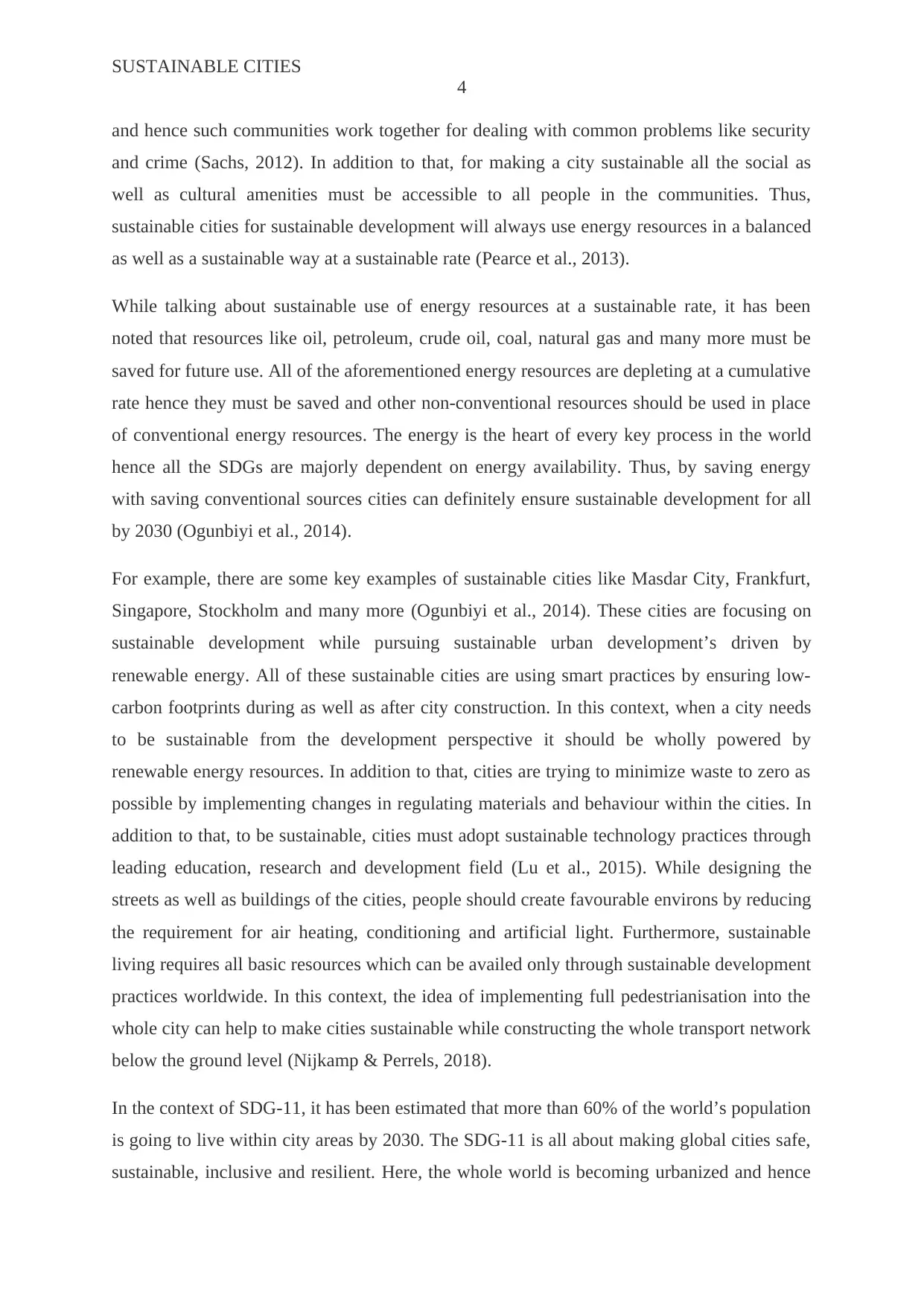
SUSTAINABLE CITIES
4
and hence such communities work together for dealing with common problems like security
and crime (Sachs, 2012). In addition to that, for making a city sustainable all the social as
well as cultural amenities must be accessible to all people in the communities. Thus,
sustainable cities for sustainable development will always use energy resources in a balanced
as well as a sustainable way at a sustainable rate (Pearce et al., 2013).
While talking about sustainable use of energy resources at a sustainable rate, it has been
noted that resources like oil, petroleum, crude oil, coal, natural gas and many more must be
saved for future use. All of the aforementioned energy resources are depleting at a cumulative
rate hence they must be saved and other non-conventional resources should be used in place
of conventional energy resources. The energy is the heart of every key process in the world
hence all the SDGs are majorly dependent on energy availability. Thus, by saving energy
with saving conventional sources cities can definitely ensure sustainable development for all
by 2030 (Ogunbiyi et al., 2014).
For example, there are some key examples of sustainable cities like Masdar City, Frankfurt,
Singapore, Stockholm and many more (Ogunbiyi et al., 2014). These cities are focusing on
sustainable development while pursuing sustainable urban development’s driven by
renewable energy. All of these sustainable cities are using smart practices by ensuring low-
carbon footprints during as well as after city construction. In this context, when a city needs
to be sustainable from the development perspective it should be wholly powered by
renewable energy resources. In addition to that, cities are trying to minimize waste to zero as
possible by implementing changes in regulating materials and behaviour within the cities. In
addition to that, to be sustainable, cities must adopt sustainable technology practices through
leading education, research and development field (Lu et al., 2015). While designing the
streets as well as buildings of the cities, people should create favourable environs by reducing
the requirement for air heating, conditioning and artificial light. Furthermore, sustainable
living requires all basic resources which can be availed only through sustainable development
practices worldwide. In this context, the idea of implementing full pedestrianisation into the
whole city can help to make cities sustainable while constructing the whole transport network
below the ground level (Nijkamp & Perrels, 2018).
In the context of SDG-11, it has been estimated that more than 60% of the world’s population
is going to live within city areas by 2030. The SDG-11 is all about making global cities safe,
sustainable, inclusive and resilient. Here, the whole world is becoming urbanized and hence
4
and hence such communities work together for dealing with common problems like security
and crime (Sachs, 2012). In addition to that, for making a city sustainable all the social as
well as cultural amenities must be accessible to all people in the communities. Thus,
sustainable cities for sustainable development will always use energy resources in a balanced
as well as a sustainable way at a sustainable rate (Pearce et al., 2013).
While talking about sustainable use of energy resources at a sustainable rate, it has been
noted that resources like oil, petroleum, crude oil, coal, natural gas and many more must be
saved for future use. All of the aforementioned energy resources are depleting at a cumulative
rate hence they must be saved and other non-conventional resources should be used in place
of conventional energy resources. The energy is the heart of every key process in the world
hence all the SDGs are majorly dependent on energy availability. Thus, by saving energy
with saving conventional sources cities can definitely ensure sustainable development for all
by 2030 (Ogunbiyi et al., 2014).
For example, there are some key examples of sustainable cities like Masdar City, Frankfurt,
Singapore, Stockholm and many more (Ogunbiyi et al., 2014). These cities are focusing on
sustainable development while pursuing sustainable urban development’s driven by
renewable energy. All of these sustainable cities are using smart practices by ensuring low-
carbon footprints during as well as after city construction. In this context, when a city needs
to be sustainable from the development perspective it should be wholly powered by
renewable energy resources. In addition to that, cities are trying to minimize waste to zero as
possible by implementing changes in regulating materials and behaviour within the cities. In
addition to that, to be sustainable, cities must adopt sustainable technology practices through
leading education, research and development field (Lu et al., 2015). While designing the
streets as well as buildings of the cities, people should create favourable environs by reducing
the requirement for air heating, conditioning and artificial light. Furthermore, sustainable
living requires all basic resources which can be availed only through sustainable development
practices worldwide. In this context, the idea of implementing full pedestrianisation into the
whole city can help to make cities sustainable while constructing the whole transport network
below the ground level (Nijkamp & Perrels, 2018).
In the context of SDG-11, it has been estimated that more than 60% of the world’s population
is going to live within city areas by 2030. The SDG-11 is all about making global cities safe,
sustainable, inclusive and resilient. Here, the whole world is becoming urbanized and hence
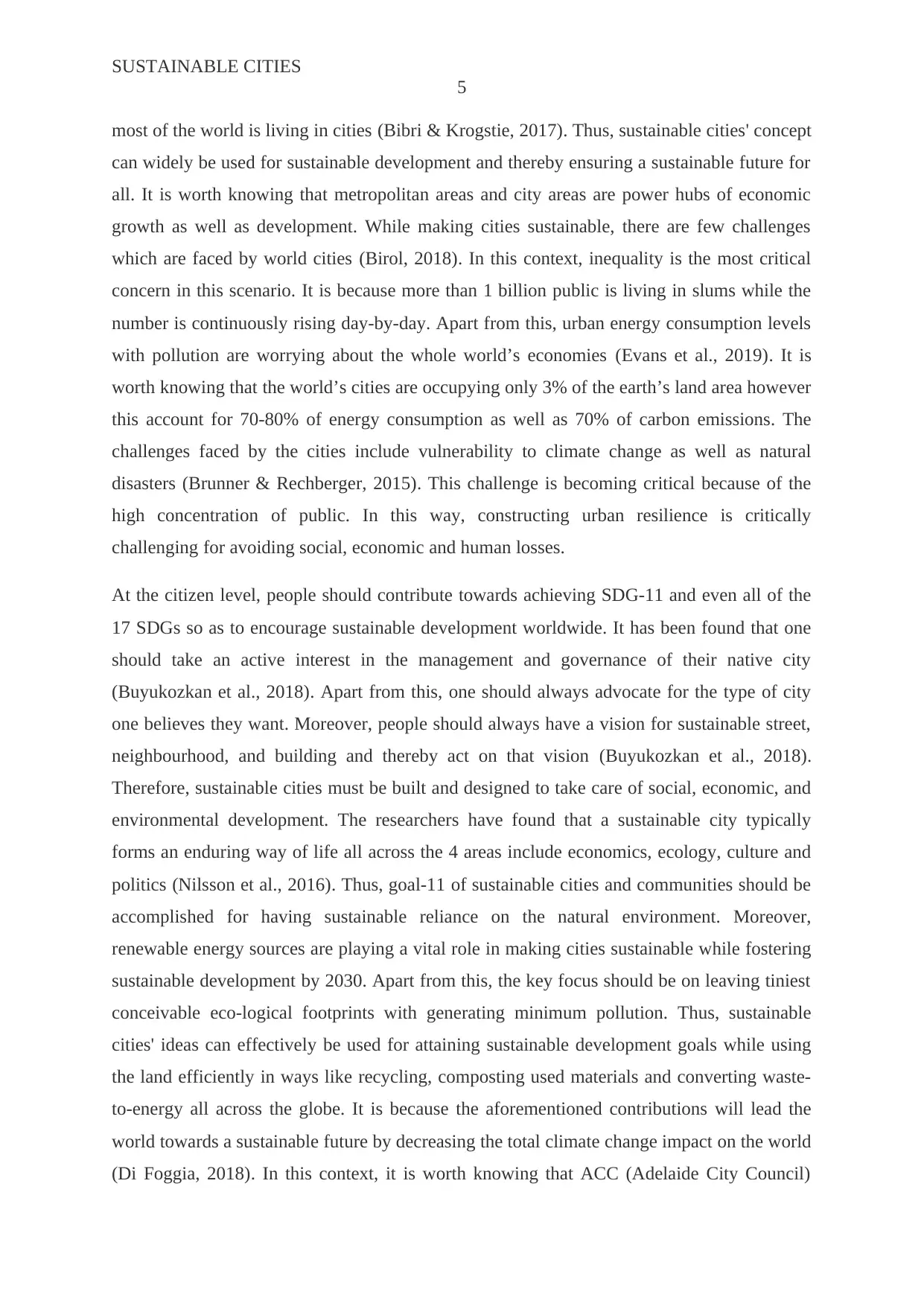
SUSTAINABLE CITIES
5
most of the world is living in cities (Bibri & Krogstie, 2017). Thus, sustainable cities' concept
can widely be used for sustainable development and thereby ensuring a sustainable future for
all. It is worth knowing that metropolitan areas and city areas are power hubs of economic
growth as well as development. While making cities sustainable, there are few challenges
which are faced by world cities (Birol, 2018). In this context, inequality is the most critical
concern in this scenario. It is because more than 1 billion public is living in slums while the
number is continuously rising day-by-day. Apart from this, urban energy consumption levels
with pollution are worrying about the whole world’s economies (Evans et al., 2019). It is
worth knowing that the world’s cities are occupying only 3% of the earth’s land area however
this account for 70-80% of energy consumption as well as 70% of carbon emissions. The
challenges faced by the cities include vulnerability to climate change as well as natural
disasters (Brunner & Rechberger, 2015). This challenge is becoming critical because of the
high concentration of public. In this way, constructing urban resilience is critically
challenging for avoiding social, economic and human losses.
At the citizen level, people should contribute towards achieving SDG-11 and even all of the
17 SDGs so as to encourage sustainable development worldwide. It has been found that one
should take an active interest in the management and governance of their native city
(Buyukozkan et al., 2018). Apart from this, one should always advocate for the type of city
one believes they want. Moreover, people should always have a vision for sustainable street,
neighbourhood, and building and thereby act on that vision (Buyukozkan et al., 2018).
Therefore, sustainable cities must be built and designed to take care of social, economic, and
environmental development. The researchers have found that a sustainable city typically
forms an enduring way of life all across the 4 areas include economics, ecology, culture and
politics (Nilsson et al., 2016). Thus, goal-11 of sustainable cities and communities should be
accomplished for having sustainable reliance on the natural environment. Moreover,
renewable energy sources are playing a vital role in making cities sustainable while fostering
sustainable development by 2030. Apart from this, the key focus should be on leaving tiniest
conceivable eco-logical footprints with generating minimum pollution. Thus, sustainable
cities' ideas can effectively be used for attaining sustainable development goals while using
the land efficiently in ways like recycling, composting used materials and converting waste-
to-energy all across the globe. It is because the aforementioned contributions will lead the
world towards a sustainable future by decreasing the total climate change impact on the world
(Di Foggia, 2018). In this context, it is worth knowing that ACC (Adelaide City Council)
5
most of the world is living in cities (Bibri & Krogstie, 2017). Thus, sustainable cities' concept
can widely be used for sustainable development and thereby ensuring a sustainable future for
all. It is worth knowing that metropolitan areas and city areas are power hubs of economic
growth as well as development. While making cities sustainable, there are few challenges
which are faced by world cities (Birol, 2018). In this context, inequality is the most critical
concern in this scenario. It is because more than 1 billion public is living in slums while the
number is continuously rising day-by-day. Apart from this, urban energy consumption levels
with pollution are worrying about the whole world’s economies (Evans et al., 2019). It is
worth knowing that the world’s cities are occupying only 3% of the earth’s land area however
this account for 70-80% of energy consumption as well as 70% of carbon emissions. The
challenges faced by the cities include vulnerability to climate change as well as natural
disasters (Brunner & Rechberger, 2015). This challenge is becoming critical because of the
high concentration of public. In this way, constructing urban resilience is critically
challenging for avoiding social, economic and human losses.
At the citizen level, people should contribute towards achieving SDG-11 and even all of the
17 SDGs so as to encourage sustainable development worldwide. It has been found that one
should take an active interest in the management and governance of their native city
(Buyukozkan et al., 2018). Apart from this, one should always advocate for the type of city
one believes they want. Moreover, people should always have a vision for sustainable street,
neighbourhood, and building and thereby act on that vision (Buyukozkan et al., 2018).
Therefore, sustainable cities must be built and designed to take care of social, economic, and
environmental development. The researchers have found that a sustainable city typically
forms an enduring way of life all across the 4 areas include economics, ecology, culture and
politics (Nilsson et al., 2016). Thus, goal-11 of sustainable cities and communities should be
accomplished for having sustainable reliance on the natural environment. Moreover,
renewable energy sources are playing a vital role in making cities sustainable while fostering
sustainable development by 2030. Apart from this, the key focus should be on leaving tiniest
conceivable eco-logical footprints with generating minimum pollution. Thus, sustainable
cities' ideas can effectively be used for attaining sustainable development goals while using
the land efficiently in ways like recycling, composting used materials and converting waste-
to-energy all across the globe. It is because the aforementioned contributions will lead the
world towards a sustainable future by decreasing the total climate change impact on the world
(Di Foggia, 2018). In this context, it is worth knowing that ACC (Adelaide City Council)
⊘ This is a preview!⊘
Do you want full access?
Subscribe today to unlock all pages.

Trusted by 1+ million students worldwide
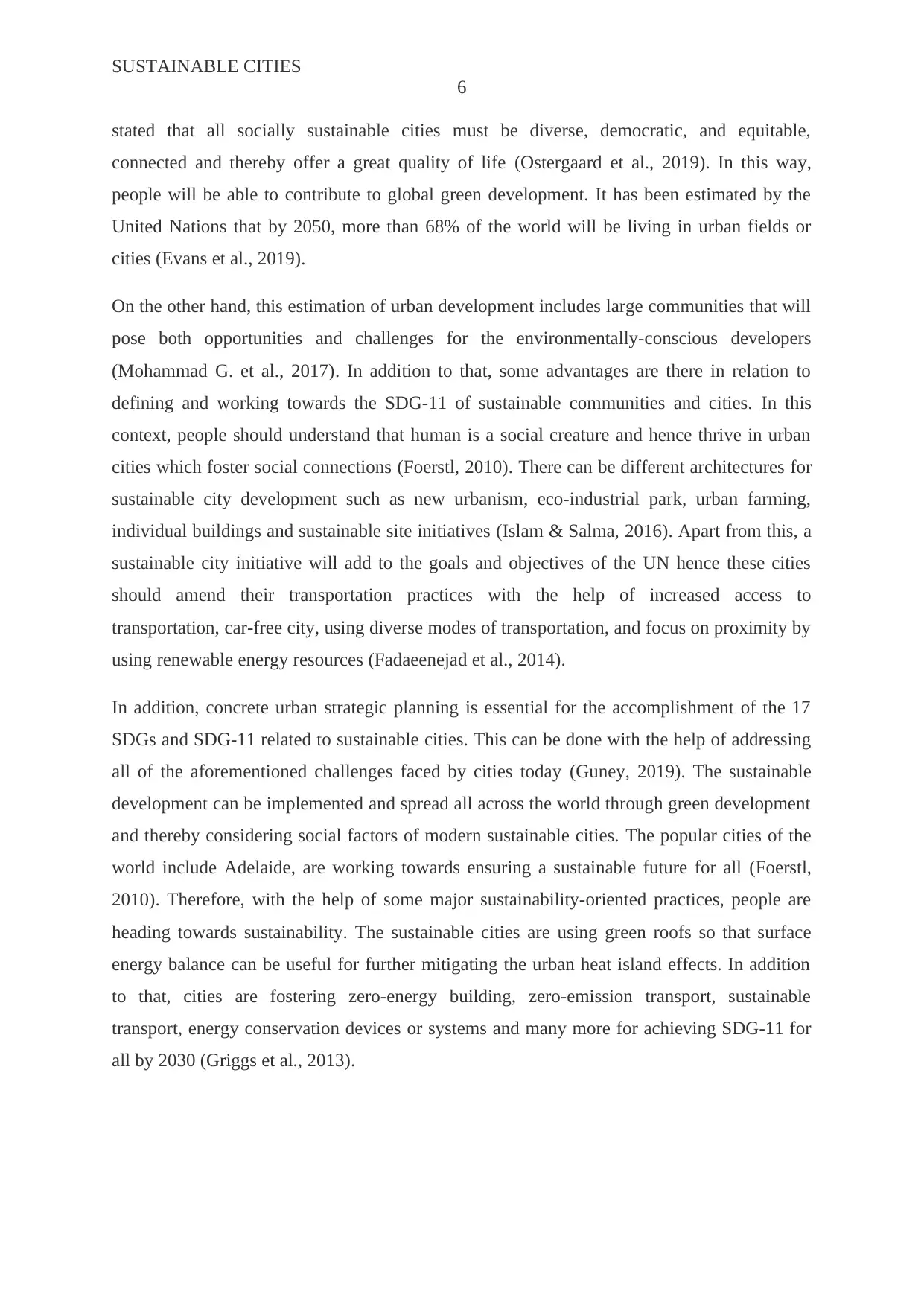
SUSTAINABLE CITIES
6
stated that all socially sustainable cities must be diverse, democratic, and equitable,
connected and thereby offer a great quality of life (Ostergaard et al., 2019). In this way,
people will be able to contribute to global green development. It has been estimated by the
United Nations that by 2050, more than 68% of the world will be living in urban fields or
cities (Evans et al., 2019).
On the other hand, this estimation of urban development includes large communities that will
pose both opportunities and challenges for the environmentally-conscious developers
(Mohammad G. et al., 2017). In addition to that, some advantages are there in relation to
defining and working towards the SDG-11 of sustainable communities and cities. In this
context, people should understand that human is a social creature and hence thrive in urban
cities which foster social connections (Foerstl, 2010). There can be different architectures for
sustainable city development such as new urbanism, eco-industrial park, urban farming,
individual buildings and sustainable site initiatives (Islam & Salma, 2016). Apart from this, a
sustainable city initiative will add to the goals and objectives of the UN hence these cities
should amend their transportation practices with the help of increased access to
transportation, car-free city, using diverse modes of transportation, and focus on proximity by
using renewable energy resources (Fadaeenejad et al., 2014).
In addition, concrete urban strategic planning is essential for the accomplishment of the 17
SDGs and SDG-11 related to sustainable cities. This can be done with the help of addressing
all of the aforementioned challenges faced by cities today (Guney, 2019). The sustainable
development can be implemented and spread all across the world through green development
and thereby considering social factors of modern sustainable cities. The popular cities of the
world include Adelaide, are working towards ensuring a sustainable future for all (Foerstl,
2010). Therefore, with the help of some major sustainability-oriented practices, people are
heading towards sustainability. The sustainable cities are using green roofs so that surface
energy balance can be useful for further mitigating the urban heat island effects. In addition
to that, cities are fostering zero-energy building, zero-emission transport, sustainable
transport, energy conservation devices or systems and many more for achieving SDG-11 for
all by 2030 (Griggs et al., 2013).
6
stated that all socially sustainable cities must be diverse, democratic, and equitable,
connected and thereby offer a great quality of life (Ostergaard et al., 2019). In this way,
people will be able to contribute to global green development. It has been estimated by the
United Nations that by 2050, more than 68% of the world will be living in urban fields or
cities (Evans et al., 2019).
On the other hand, this estimation of urban development includes large communities that will
pose both opportunities and challenges for the environmentally-conscious developers
(Mohammad G. et al., 2017). In addition to that, some advantages are there in relation to
defining and working towards the SDG-11 of sustainable communities and cities. In this
context, people should understand that human is a social creature and hence thrive in urban
cities which foster social connections (Foerstl, 2010). There can be different architectures for
sustainable city development such as new urbanism, eco-industrial park, urban farming,
individual buildings and sustainable site initiatives (Islam & Salma, 2016). Apart from this, a
sustainable city initiative will add to the goals and objectives of the UN hence these cities
should amend their transportation practices with the help of increased access to
transportation, car-free city, using diverse modes of transportation, and focus on proximity by
using renewable energy resources (Fadaeenejad et al., 2014).
In addition, concrete urban strategic planning is essential for the accomplishment of the 17
SDGs and SDG-11 related to sustainable cities. This can be done with the help of addressing
all of the aforementioned challenges faced by cities today (Guney, 2019). The sustainable
development can be implemented and spread all across the world through green development
and thereby considering social factors of modern sustainable cities. The popular cities of the
world include Adelaide, are working towards ensuring a sustainable future for all (Foerstl,
2010). Therefore, with the help of some major sustainability-oriented practices, people are
heading towards sustainability. The sustainable cities are using green roofs so that surface
energy balance can be useful for further mitigating the urban heat island effects. In addition
to that, cities are fostering zero-energy building, zero-emission transport, sustainable
transport, energy conservation devices or systems and many more for achieving SDG-11 for
all by 2030 (Griggs et al., 2013).
Paraphrase This Document
Need a fresh take? Get an instant paraphrase of this document with our AI Paraphraser
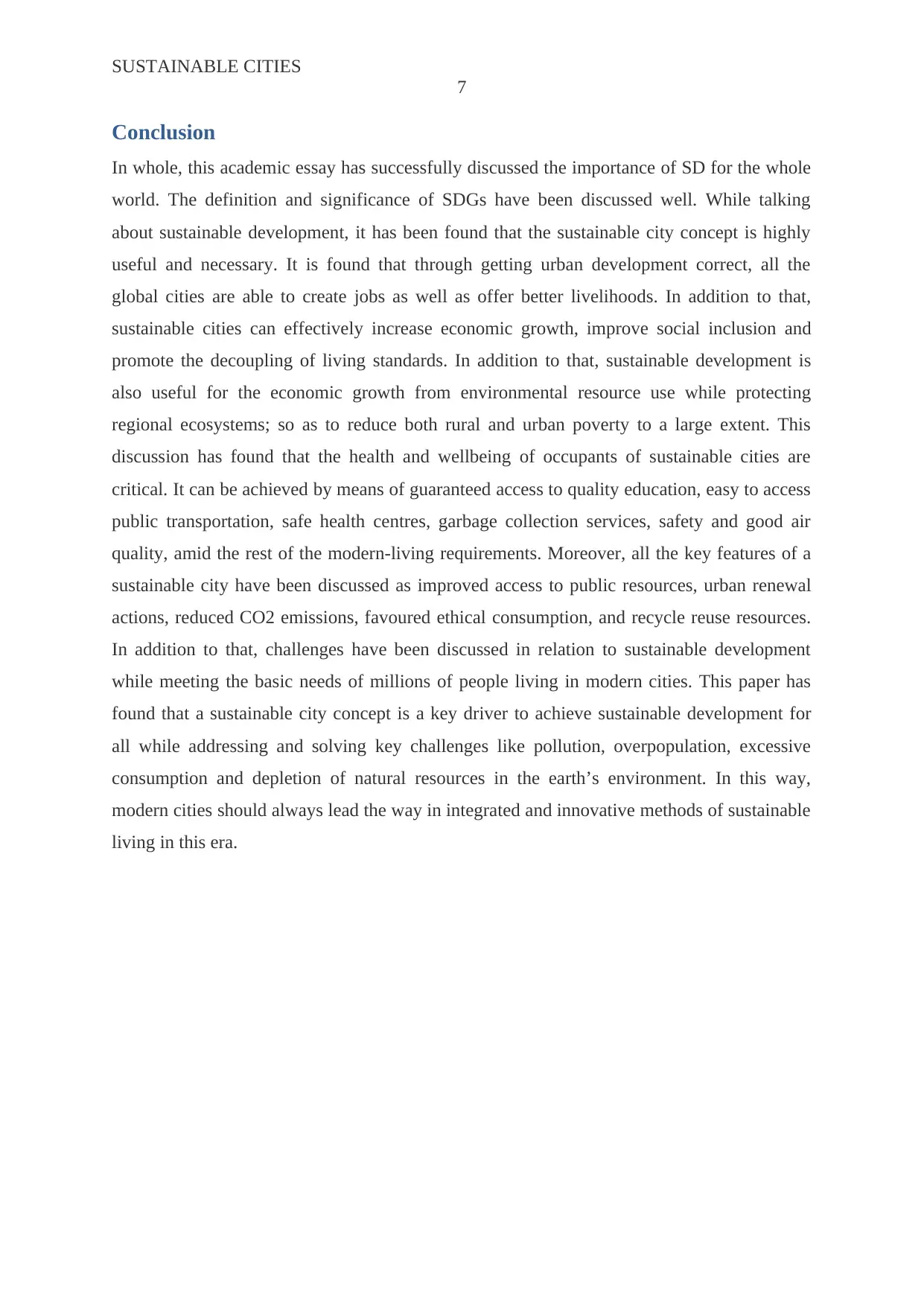
SUSTAINABLE CITIES
7
Conclusion
In whole, this academic essay has successfully discussed the importance of SD for the whole
world. The definition and significance of SDGs have been discussed well. While talking
about sustainable development, it has been found that the sustainable city concept is highly
useful and necessary. It is found that through getting urban development correct, all the
global cities are able to create jobs as well as offer better livelihoods. In addition to that,
sustainable cities can effectively increase economic growth, improve social inclusion and
promote the decoupling of living standards. In addition to that, sustainable development is
also useful for the economic growth from environmental resource use while protecting
regional ecosystems; so as to reduce both rural and urban poverty to a large extent. This
discussion has found that the health and wellbeing of occupants of sustainable cities are
critical. It can be achieved by means of guaranteed access to quality education, easy to access
public transportation, safe health centres, garbage collection services, safety and good air
quality, amid the rest of the modern-living requirements. Moreover, all the key features of a
sustainable city have been discussed as improved access to public resources, urban renewal
actions, reduced CO2 emissions, favoured ethical consumption, and recycle reuse resources.
In addition to that, challenges have been discussed in relation to sustainable development
while meeting the basic needs of millions of people living in modern cities. This paper has
found that a sustainable city concept is a key driver to achieve sustainable development for
all while addressing and solving key challenges like pollution, overpopulation, excessive
consumption and depletion of natural resources in the earth’s environment. In this way,
modern cities should always lead the way in integrated and innovative methods of sustainable
living in this era.
7
Conclusion
In whole, this academic essay has successfully discussed the importance of SD for the whole
world. The definition and significance of SDGs have been discussed well. While talking
about sustainable development, it has been found that the sustainable city concept is highly
useful and necessary. It is found that through getting urban development correct, all the
global cities are able to create jobs as well as offer better livelihoods. In addition to that,
sustainable cities can effectively increase economic growth, improve social inclusion and
promote the decoupling of living standards. In addition to that, sustainable development is
also useful for the economic growth from environmental resource use while protecting
regional ecosystems; so as to reduce both rural and urban poverty to a large extent. This
discussion has found that the health and wellbeing of occupants of sustainable cities are
critical. It can be achieved by means of guaranteed access to quality education, easy to access
public transportation, safe health centres, garbage collection services, safety and good air
quality, amid the rest of the modern-living requirements. Moreover, all the key features of a
sustainable city have been discussed as improved access to public resources, urban renewal
actions, reduced CO2 emissions, favoured ethical consumption, and recycle reuse resources.
In addition to that, challenges have been discussed in relation to sustainable development
while meeting the basic needs of millions of people living in modern cities. This paper has
found that a sustainable city concept is a key driver to achieve sustainable development for
all while addressing and solving key challenges like pollution, overpopulation, excessive
consumption and depletion of natural resources in the earth’s environment. In this way,
modern cities should always lead the way in integrated and innovative methods of sustainable
living in this era.
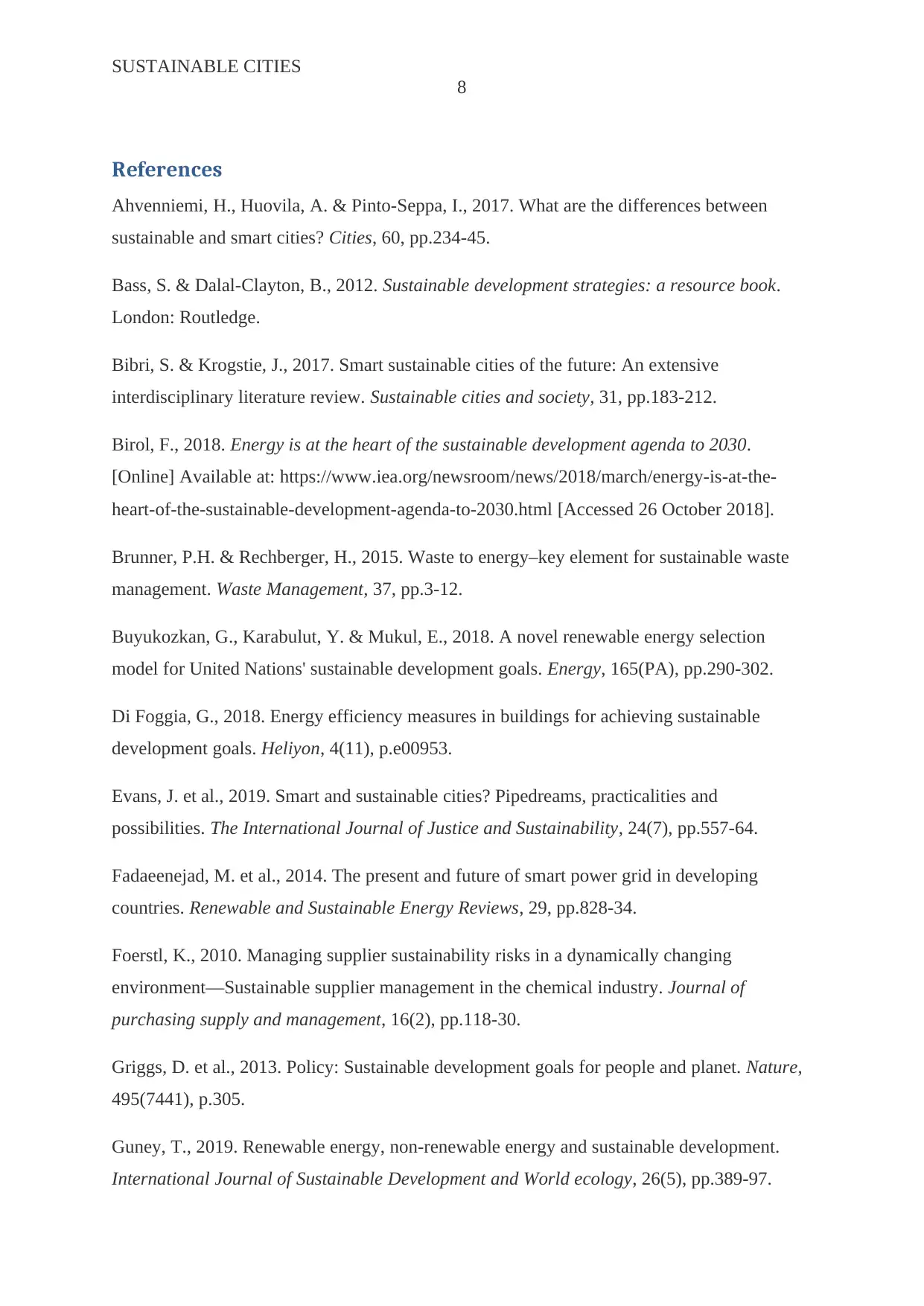
SUSTAINABLE CITIES
8
References
Ahvenniemi, H., Huovila, A. & Pinto-Seppa, I., 2017. What are the differences between
sustainable and smart cities? Cities, 60, pp.234-45.
Bass, S. & Dalal-Clayton, B., 2012. Sustainable development strategies: a resource book.
London: Routledge.
Bibri, S. & Krogstie, J., 2017. Smart sustainable cities of the future: An extensive
interdisciplinary literature review. Sustainable cities and society, 31, pp.183-212.
Birol, F., 2018. Energy is at the heart of the sustainable development agenda to 2030.
[Online] Available at: https://www.iea.org/newsroom/news/2018/march/energy-is-at-the-
heart-of-the-sustainable-development-agenda-to-2030.html [Accessed 26 October 2018].
Brunner, P.H. & Rechberger, H., 2015. Waste to energy–key element for sustainable waste
management. Waste Management, 37, pp.3-12.
Buyukozkan, G., Karabulut, Y. & Mukul, E., 2018. A novel renewable energy selection
model for United Nations' sustainable development goals. Energy, 165(PA), pp.290-302.
Di Foggia, G., 2018. Energy efficiency measures in buildings for achieving sustainable
development goals. Heliyon, 4(11), p.e00953.
Evans, J. et al., 2019. Smart and sustainable cities? Pipedreams, practicalities and
possibilities. The International Journal of Justice and Sustainability, 24(7), pp.557-64.
Fadaeenejad, M. et al., 2014. The present and future of smart power grid in developing
countries. Renewable and Sustainable Energy Reviews, 29, pp.828-34.
Foerstl, K., 2010. Managing supplier sustainability risks in a dynamically changing
environment—Sustainable supplier management in the chemical industry. Journal of
purchasing supply and management, 16(2), pp.118-30.
Griggs, D. et al., 2013. Policy: Sustainable development goals for people and planet. Nature,
495(7441), p.305.
Guney, T., 2019. Renewable energy, non-renewable energy and sustainable development.
International Journal of Sustainable Development and World ecology, 26(5), pp.389-97.
8
References
Ahvenniemi, H., Huovila, A. & Pinto-Seppa, I., 2017. What are the differences between
sustainable and smart cities? Cities, 60, pp.234-45.
Bass, S. & Dalal-Clayton, B., 2012. Sustainable development strategies: a resource book.
London: Routledge.
Bibri, S. & Krogstie, J., 2017. Smart sustainable cities of the future: An extensive
interdisciplinary literature review. Sustainable cities and society, 31, pp.183-212.
Birol, F., 2018. Energy is at the heart of the sustainable development agenda to 2030.
[Online] Available at: https://www.iea.org/newsroom/news/2018/march/energy-is-at-the-
heart-of-the-sustainable-development-agenda-to-2030.html [Accessed 26 October 2018].
Brunner, P.H. & Rechberger, H., 2015. Waste to energy–key element for sustainable waste
management. Waste Management, 37, pp.3-12.
Buyukozkan, G., Karabulut, Y. & Mukul, E., 2018. A novel renewable energy selection
model for United Nations' sustainable development goals. Energy, 165(PA), pp.290-302.
Di Foggia, G., 2018. Energy efficiency measures in buildings for achieving sustainable
development goals. Heliyon, 4(11), p.e00953.
Evans, J. et al., 2019. Smart and sustainable cities? Pipedreams, practicalities and
possibilities. The International Journal of Justice and Sustainability, 24(7), pp.557-64.
Fadaeenejad, M. et al., 2014. The present and future of smart power grid in developing
countries. Renewable and Sustainable Energy Reviews, 29, pp.828-34.
Foerstl, K., 2010. Managing supplier sustainability risks in a dynamically changing
environment—Sustainable supplier management in the chemical industry. Journal of
purchasing supply and management, 16(2), pp.118-30.
Griggs, D. et al., 2013. Policy: Sustainable development goals for people and planet. Nature,
495(7441), p.305.
Guney, T., 2019. Renewable energy, non-renewable energy and sustainable development.
International Journal of Sustainable Development and World ecology, 26(5), pp.389-97.
⊘ This is a preview!⊘
Do you want full access?
Subscribe today to unlock all pages.

Trusted by 1+ million students worldwide
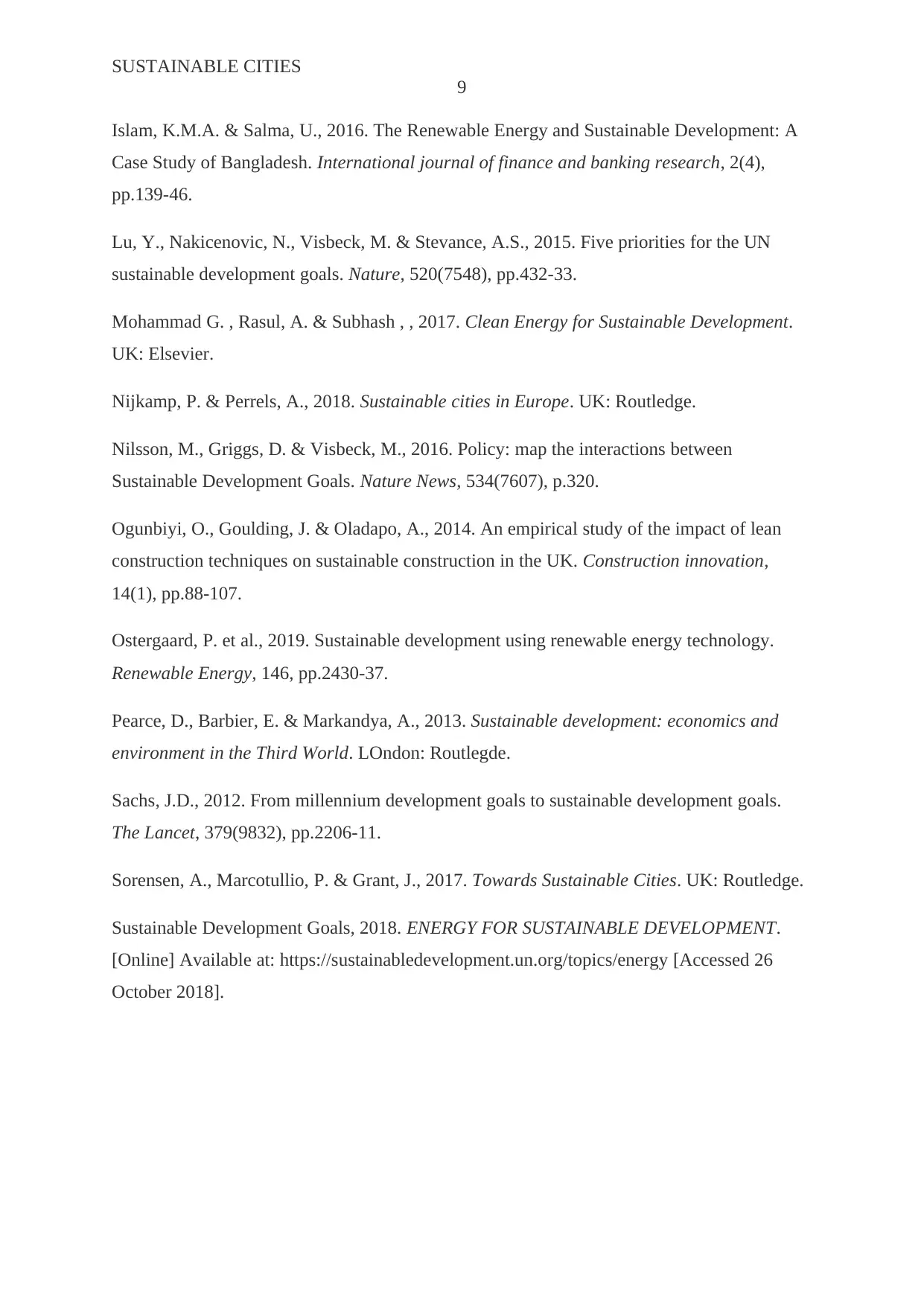
SUSTAINABLE CITIES
9
Islam, K.M.A. & Salma, U., 2016. The Renewable Energy and Sustainable Development: A
Case Study of Bangladesh. International journal of finance and banking research, 2(4),
pp.139-46.
Lu, Y., Nakicenovic, N., Visbeck, M. & Stevance, A.S., 2015. Five priorities for the UN
sustainable development goals. Nature, 520(7548), pp.432-33.
Mohammad G. , Rasul, A. & Subhash , , 2017. Clean Energy for Sustainable Development.
UK: Elsevier.
Nijkamp, P. & Perrels, A., 2018. Sustainable cities in Europe. UK: Routledge.
Nilsson, M., Griggs, D. & Visbeck, M., 2016. Policy: map the interactions between
Sustainable Development Goals. Nature News, 534(7607), p.320.
Ogunbiyi, O., Goulding, J. & Oladapo, A., 2014. An empirical study of the impact of lean
construction techniques on sustainable construction in the UK. Construction innovation,
14(1), pp.88-107.
Ostergaard, P. et al., 2019. Sustainable development using renewable energy technology.
Renewable Energy, 146, pp.2430-37.
Pearce, D., Barbier, E. & Markandya, A., 2013. Sustainable development: economics and
environment in the Third World. LOndon: Routlegde.
Sachs, J.D., 2012. From millennium development goals to sustainable development goals.
The Lancet, 379(9832), pp.2206-11.
Sorensen, A., Marcotullio, P. & Grant, J., 2017. Towards Sustainable Cities. UK: Routledge.
Sustainable Development Goals, 2018. ENERGY FOR SUSTAINABLE DEVELOPMENT.
[Online] Available at: https://sustainabledevelopment.un.org/topics/energy [Accessed 26
October 2018].
9
Islam, K.M.A. & Salma, U., 2016. The Renewable Energy and Sustainable Development: A
Case Study of Bangladesh. International journal of finance and banking research, 2(4),
pp.139-46.
Lu, Y., Nakicenovic, N., Visbeck, M. & Stevance, A.S., 2015. Five priorities for the UN
sustainable development goals. Nature, 520(7548), pp.432-33.
Mohammad G. , Rasul, A. & Subhash , , 2017. Clean Energy for Sustainable Development.
UK: Elsevier.
Nijkamp, P. & Perrels, A., 2018. Sustainable cities in Europe. UK: Routledge.
Nilsson, M., Griggs, D. & Visbeck, M., 2016. Policy: map the interactions between
Sustainable Development Goals. Nature News, 534(7607), p.320.
Ogunbiyi, O., Goulding, J. & Oladapo, A., 2014. An empirical study of the impact of lean
construction techniques on sustainable construction in the UK. Construction innovation,
14(1), pp.88-107.
Ostergaard, P. et al., 2019. Sustainable development using renewable energy technology.
Renewable Energy, 146, pp.2430-37.
Pearce, D., Barbier, E. & Markandya, A., 2013. Sustainable development: economics and
environment in the Third World. LOndon: Routlegde.
Sachs, J.D., 2012. From millennium development goals to sustainable development goals.
The Lancet, 379(9832), pp.2206-11.
Sorensen, A., Marcotullio, P. & Grant, J., 2017. Towards Sustainable Cities. UK: Routledge.
Sustainable Development Goals, 2018. ENERGY FOR SUSTAINABLE DEVELOPMENT.
[Online] Available at: https://sustainabledevelopment.un.org/topics/energy [Accessed 26
October 2018].
1 out of 10
Related Documents
Your All-in-One AI-Powered Toolkit for Academic Success.
+13062052269
info@desklib.com
Available 24*7 on WhatsApp / Email
![[object Object]](/_next/static/media/star-bottom.7253800d.svg)
Unlock your academic potential
Copyright © 2020–2025 A2Z Services. All Rights Reserved. Developed and managed by ZUCOL.




